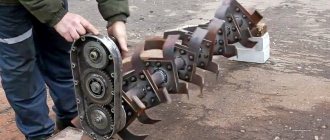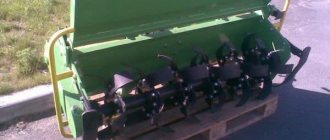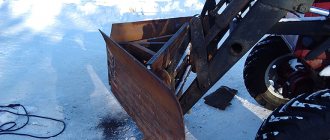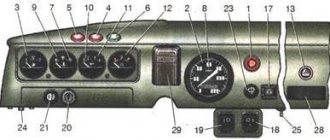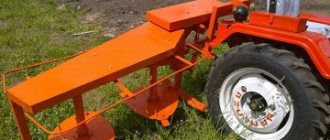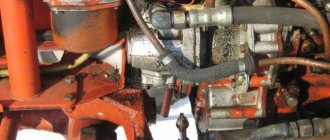A sawmill is a woodworking machine used for longitudinal sawing of blanks from various types of wood. It was invented in the Bronze Age and was originally used in shipbuilding. To construct a sawmill with your own hands, you need to know the structure, operating principle and main types of this unit.
Design and operating principles
The main advantage of the sawmill is that it cuts logs lengthwise. Doing this manually is incredibly difficult.
To understand the principle of operation of the machine, you need to get acquainted with its structure. The design consists of several parts:
- saws;
- drive (usually electric, sometimes gasoline engine);
- saw carriages;
- guides;
- frames
The base of the U-shaped structure is metal beams or channels fastened together, along which rollers mounted on the frame move. On one side of the frame there is a stationary main wheel, on the other there is a movable one that moves along the frame.
At the base of the machine, above the rollers, there are guides, on which support posts are attached on top. The frame moves along the beams using a chain mechanism.
The cutting tool is a band saw approximately 6 cm wide. It is tensioned using hydraulics. The tape is held in place by special locks attached to the base of the main wheel.
The design is complemented by a ruler and a container with a special liquid that flows into the cutting area and protects the tape from the adhesion of sawdust.
There are several types of sawmills. The most common are belt, disk and chain. Almost any of them can be done independently, if you take as a basis a competent drawing of a homemade sawmill and carefully watch the video with step-by-step instructions. Mechanisms constructed using a chainsaw are also popular.
Note!
DIY induction heater ♨️ - reviews of the best manufacturing options. Varieties of homemade device designs + step-by-step master class (160 photos)
Do-it-yourself Gauss cannon: TOP-130 photos of the best ways to create it yourself. Design features + master class for beginners
- DIY clamps - a step-by-step master class for beginners. Schemes for manufacturing different designs + 170 photos
How to make
Let's take a closer look at how to make your own sawmill from a regular chainsaw using the example of a stationary structure.
What you need
For work you will need the following materials:
- Chainsaw.
- Welding machine.
- Square metal pipes.
- Metal squares.
- Rollers.
Expert opinion Kulikov Vladimir Sergeevich
If square metal pipes are not available, you can use regular water pipes instead. Only in this case it is necessary to select pipes of sufficient strength. But it is best to use metal channels, if possible. It is more convenient to work with them during installation, and they can be fixed more reliably.
Manufacturing process
To manufacture the device you will have to perform the following steps:
- Assemble the base of the future sawmill from pipes and angles. There is no need to install the structure immediately. First you need to fold it and check how smoothly all the elements are connected. They do this using a level. Only after this the pipes are connected to each other by welding.
- When the base rectangle is assembled, for greater structural strength it must be strengthened with at least two ties. They can be made from the same metal pipes. The ties are fastened transversely at an equal distance from each other. The best mounting option is bolted.
- Then thinner pipes or metal profiles are welded on top of the pipes from which the base of the structure is assembled. They will serve as guides for the logs being cut and will not allow them to fall off the sawmill. Transverse guides are also welded. Ideally, they should rotate - this will ensure smoother movement of the log and minimize the effort that needs to be applied during operation of the device.
You can do without transverse guides if you used round pipe ties. The log will also move along them quite easily. But you need to remember that its movement will not be as easy as in the case of rotating transverse guides.
- After the base is completely ready, it is installed on racks. Steel squares are best suited for their role. They are welded in the corners of the base. For greater structural strength, braces can be welded between the posts.
- Afterwards, the trolley for the cutting part is assembled. It is a rectangle of metal pipes supported by two longitudinal steel strips. Between these strips and the walls of the rectangle, two slopes are installed so that the structure is stable. Rollers are placed under the strips, which will ensure the movement of the cutting part along the base. Then another pipe is welded to one of the strips, connecting it to the rectangle on top. This is the attachment point for the saw.
- When the cart is ready, secure the saw. This can be done in a variety of ways. The most common method is to secure the saw body using clamps or metal ties. It is quite reliable and does not cause irreversible damage to the device. If necessary, additional transverse strips are welded to the trolley from the same pipes from which the remaining parts of the structure were made.
There is another way to fix the saw - by the blade on which the chain is attached. It is less reliable, requires drilling out the blade and holds the chainsaw worse. However, with this installation method, the saw chain vibrates less (most of the vibration is transferred to the base of the sawmill) and makes smoother cuts.
Homemade band sawmill
Self-assembly of a complex unit is not an easy process. It is necessary to correctly install and adjust all structural parts to ensure their smooth, uninterrupted operation. This will help you with instructions on how to make a homemade sawmill, following which you can acquire your own home woodworking complex.
To assemble the sawmill, a suitable site should be identified and prepared. Then the assembly of the frame of the future structure begins. First, a kind of rails are prepared along which the working saw will move with the help of rollers. The rails are fastened together with profile pipes that act as sleepers. Fasteners are welded to them to secure the logs.
At the next stage, a trolley is mounted on which special wheels for the tape are installed. Many craftsmen who assemble homemade band sawmills with their own hands have thought of adapting old car wheels for these purposes.
The assembly of the structure is completed by installing an electric motor connected to the moving mechanism using a drive belt.
Introduction
The crisis forces us to look at old processes with new eyes. Somewhere sawmills are closing, and somewhere, on the contrary, they decide to open a sawmill. As a rule, private owners have recently opened sawmills; their costs are lower and efficiency is higher. Here you don’t need a business plan for a sawmill, but if it comes in handy, come here!
Sometimes the word “open” is too strong. They simply set up a sawmill for use at home, for example to build a house, or, in extreme cases, to cut a log for a neighbor. This is the case we are considering.
When opening your own sawmill, there are several options on how best to do this:
- Buy inexpensive equipment;
- Do it yourself.
Again, to build a house and get 3 - 5 cubic meters of boards, buying a sawmill for 50 - 150 thousand is just some kind of waste. After all, our boards will cost several times less: 18 - 30 thousand rubles.
There is a way out, make a sawmill from a chainsaw. This will not take you much time if you have hands that grow from the right place. In addition, it will serve you faithfully for a long time, because having your own sawmill is a fairly profitable business today.
DIY chain sawmill
The design of this unit is simpler and smaller in size than its belt counterpart. It works on the same principle, differing only in the type of saw. In this case, a special chain stretched over a tire is used to cut logs.
It is much easier to make it; you just need to strictly follow the tips on how to make a homemade chain-type sawmill.
Note!
- Do-it-yourself electric scooter - a master class with step-by-step instructions for doing it yourself. Tips and simple patterns for beginners + the best photo reviews
- DIY rocking chair: TOP-120 photos of the best manufacturing options. Master class on creating a rocking chair at home
Smokehouse from a gas cylinder - the best master class on making a homemade smokehouse with step-by-step photo diagrams for beginners
What needs to be provided?
Before making, you need to pay attention to the following things:
- The diameter of the logs being cut, if there are large diameters, then you need a more powerful saw, a longer bar with chain;
- Loading heavy logs for sawing, for this it is necessary to provide some kind of mechanism, or they can be rolled up either by additional jacks or, ideally, by a loader;
- The log must be fixed so that it does not play during sawing and the boards are even;
- The chainsaw guide and sled should not play, so they need to be strengthened;
- The more powerful the saw, the easier production will be. Therefore, when purchasing a saw, you need to take the most powerful one;
- Using electricity as an energy source allows you to save a lot;
- Do not forget that the chain must be for longitudinal sawing, this will significantly increase the speed of the process. Experts recommend using a 3*8 chain.
- It is advisable to buy a carbide chain. This is what he is doing today. Conventional circuits fail quite quickly;
- The length of the logs to be cut must take into account the maximum and minimum. So that the longest ones fit in, and the shortest ones don’t fall between the guides;
- Calculate in such a way that the saw does not vibrate or play on the guides during operation;
- The power of the saw, in some cases you want it to be both more powerful and more economical. In this case, folk craftsmen do the following. Instead of a chainsaw, an electric motor is installed, and the tire is left for sawing, see photo below;
- The height of the sawmill. It is necessary to provide in such a way that the back does not hurt to bend over and the logs do not need to be lifted high. If the wood is not heavy, it is better to make it higher. If the forest is heavy, you can go lower.
- Sawing of wood can be carried out either by the upper part of the tire or by the lower part. When sawing with the lower part, sawdust flies towards the chainsaw and clogs it. The upper part throws out sawdust from the chainsaw, this allows you to increase both the service life of the saw and the downtime during sawing;
- During the sawing process, the chain very often stretches on the saw and needs tensioning. Therefore, when installing the saw, it is necessary to provide access to the chain tension and secure the saw with access to the mechanism;
- When sawing, it is better to fix the position of the chainsaw handle, this simplifies the process;
- The cable, clothesline or lace should not drag, since the sawing process should be uniform over time.
Assembly of a chain (tire) sawmill
Before starting assembly work, prepare a flat, open area. Then a metal frame is assembled, onto which the racks are attached and the frame is installed as the basis of the chain structure.
At the next stage, the trolley is assembled, on which the mounts for the electric motor are mounted.
Next, the cart is installed on the frame, and the engine and saw are mounted on it.
The last assembly step is to tension the chain onto the bar, and the sawmill is ready for use.
Homemade circular sawmill
A unit that is capable of sawing logs horizontally, vertically or at an angle is called an angle-rotating disc sawmill. This type of woodworking machines is very popular due to its versatility. Ready-made equipment of this type is not cheap, so it will be much more profitable to make a circular sawmill with your own hands.
Note!
- Do-it-yourself compressor: TOP-130 photo reviews of finished compressors. Step-by-step instructions + diagrams and drawings
- Do-it-yourself wind generator: TOP-170 photo reviews of finished devices. Detailed DIY instructions for beginners
- Do-it-yourself spot welding - the best master class on making homemade spot welding with step-by-step photo diagrams of do-it-yourself work
The design of this mechanism is not particularly complicated, so it will be easy to assemble it yourself. A drawing, instructions and visual pictures of a homemade disc-type sawmill will help with this.
Self-assembly of a disk unit
The work begins with the acquisition of the necessary parts, assemblies and components. Then you can begin assembling the frame. Metal pipes and high-strength guides are used, which are attached by welding. The next step is to assemble the carriage.
A powerful engine is required to rotate the metal disk, so in most cases a gasoline version is used. The working elements of the unit are connected to the engine through special holes.
This usually happens using a chain drive, but in this case the sawmill will not be able to operate continuously for a long time - the drive will constantly overheat.
A rapidly rotating saw blade is a source of increased danger, therefore, during installation, all risks should be taken into account and all safety conditions must be observed.
Types of PVC panels for bathroom finishing
The classification of products is conditional, depending on the intended purpose and strength characteristics:
- Plastic panels for walls with increased strength of the front wall, reinforced stiffeners, a total thickness of 8-12 mm.
- Lightweight panels for finishing the bathroom ceiling with a thickness of 5-8 mm. They are inferior to wall varieties in strength, but gain in weight and choice of sizes.
Types of panels for the bathroom
Depending on the shape and geometric dimensions, all PVC panels for finishing the bathroom are:
- Slatted (plastic lining) with a width ranging from 10-30 cm, a standard length from 0.9 to 3 m for wall types, up to 6-12 m for ceiling types. When decorating the walls with plastic lining in the bathroom, you can visually expand or narrow the space by changing the direction of the stripes, but in general this type is better for covering ceilings.
- Standard PVC panels with widths from 15 to 50 cm, lengths up to 2.7 and 3 m. These dimensions are considered optimal for installing panels on walls.
- Large-sized sheet panels with a width from 50 to 203 cm, a length from 1 to 4 m. This group is represented by both single-color and decorated with photo printing products, mounted end-to-end, the advantages of which include the ability to cover the entire wall or ceiling at once. Unlike standard PVC panels, sheet varieties have a continuous structure with a thickness of no more than 5 mm.
- Tile varieties with side sizes ranging from 30-98 cm.
Types of PVC panels for bathroom
Many PVC panels for bathroom finishing have a tongue-and-groove edge joining system. But the appearance of the coatings after joining can be different:
- Panels that form smooth, seamless coverings due to their tight fit to each other and a special profile of the grooves. Seamless plastic panels are often used to cover ceilings and areas of active moisture exposure.
- Products with a relief surface, forming complex unified patterns after joining. With the help of such panels, decorative finishing of walls is carried out; in terms of their performance characteristics and installation method, they are similar to lining.
- Rustic panels with chamfered joints, allowing to obtain beautiful continuous coatings and are equally successfully used for cladding walls and ceilings.
Types of PVC panels for the bathroom
A separate classification concerns the structure of PVC panels for the bathroom. In addition to hollow materials reinforced with stiffeners and solid sheets when finishing a bathroom with plastic, multilayer sandwich panels with an insulating layer of compacted polystyrene can be used. This type of plastic panels is recommended for quick construction of thin internal partitions or laying insulated slopes.
Depending on the method of coloring the plastic and the decorative properties of the materials, they are divided into:
- Plain panels painted throughout the entire structure
- Laminated, with increased strength, resistance to wear and fading
- Decorative types obtained by offset photo printing. There are matte and glossy depending on the type of protective varnish used.
Choosing a color for painting panels
These methods of painting and decorating are used with equal success for smooth, mosaic, textured types of PVC tiles for walls and ceilings; the choice of their colors and textures is practically unlimited.
Mobile chainsaw design
Complex structures are more often used in those cases when the harvesting of lumber reaches an industrial scale. In particular cases, simpler and smaller mobile devices are required, which can be made independently.
One of the best options for such a mini-machine is considered to be a homemade sawmill made from a chainsaw, which plays a major role in the design. The product is light in weight and compact in size, allowing it to be moved from one place to another.
Making a homemade chainsaw machine
The main structural elements required for assembly are a chainsaw, a pair of channels, metal angles and rails.
First, a frame is assembled, in which holes are drilled for installing ties from metal pipes. During assembly work, it is imperative to ensure the accuracy of dimensions and observance of right angles. To strengthen the frame, it is recommended to weld several stiffeners.
At the next stage, the movable cart is assembled. Its basis is a steel plate, to which corners are welded from below and rollers are mounted. Fasteners for gas-powered tools are installed in the upper part.
At the last stage, a structure with fastenings for logs is installed on the frame.
Carriage, grips, clamps
There remains such a problem as a frame with additional components. The one on pos. 1 pic. the left is far from optimal. For one-time sawing for self-construction, it is too complex and expensive. It is also not suitable for long-term regular use: even if the supporting frame is made of a 200 mm channel, it will not sag after the first or second dozen logs, which means the machine is completely unsuitable. A stationary sawmill should be made with separate concrete rail tracks and a carriage for logs (item 2; in this case we will not focus on safety precautions - the topic of this article is different).
Irrational and rational designs of the frame, carriage and log grippers of a homemade sawmill
The next tasks are leveling and holding the log. In industrial woodworking, hydraulic jacks with hooks are used for this purpose. The log is hung on the hoist, lowered onto the carriage without touching it, the jacks turn on and grab it tightly. In automated carriages, a log is placed on it and hydraulics, based on sensor signals, immediately levels the timber.
In amateur conditions, the first is not feasible; the second is in no way feasible. In many homemade sawmills, log grippers are made as shown in Fig. below. The log is hung on automatic jacks (see below), hooks are brought to it, sliding along a guide (pipe, thick rod). The hooks are tapped with a hammer according to the principle of “lightly tapping with a sledgehammer”, they are wedged on the guides and hold the log.
An unreliable and inconvenient way to attach a log to a sawmill carriage
Firstly, such fastening is simply dangerous: vibrations during sawing can cause the grips to become wedged, and this is an accident most likely with serious consequences. Secondly, it is impossible to grab the wood by the very “bottom” in this way. This means that you will have to turn the log over before finishing it halfway. As a result, the cutting quality and material waste will be the same as on a vertical single-disc sawmill, see above.
Carriage
Let's try to develop technical requirements for a log carriage suitable, incl. for use with a portable mini sawmill when working on the road:
- materials – ordinary rolled metal without preliminary screening for evenness;
- for strength, reliability and durability - welded;
- the influence of the quality of welding and warping of the metal from it on the quality of sawing is absent;
- prepared base (support) surface – not required;
- weight and dimensions - suitable for transportation in a mini-truck, pickup truck and on the top trunk of a car;
- the maximum length of the processed log is 6 m;
- its maximum diameter is up to 1 m;
- leveling and hanging the log - in any way independent of the carriage, see below;
- the influence of the flatness of the carriage along the horizon on the quality of sawing - no;
- the reliability of holding the most clumsy, unrooted forest is absolute;
- the ability to dismantle the sawn blocks into edged measuring boards/beams without readjusting the sawmill - a must;
- security – sufficient for non-production conditions, when access to the site of untrained outsiders is easily controlled.
Drawings of a log carriage for a sawmill, incl. minis that satisfy the specified conditions are shown in Fig. (left/center – top view). Material – channel 120x60, rod 14 and 16 mm.
Exactly under the M14 holes in the upper flange of the channel, D15 holes are drilled in the lower flange for the passage of the shanks of the hook holders (on the right in the figure). The M16 holes in the bottom shelf (marked in green) are for threaded feet. The plan configuration and location of the grip holders make it possible to reliably hold both full-length logs and short logs. Use this carriage like this:
- the log is hung and leveled on a pair of auto jacks. An option is to use one jack at a time: put something suitable under the raised end, rearrange the jack and lift the other one;
- the carriage is slipped under the middle of the log with the widened part towards the butt and aligned along the axis of the timber. If the log was hung on a hoist, then the middle pair of legs should fall under its center of gravity;
- the holder hooks are turned out until they touch the log so that their points look inward exactly at each other. A slip by one turn (by M14 thread pitch) does not affect the cutting accuracy;
- the log is lowered onto the hooks. If the timber was hung on one jack and a support, then first release the jack, and then knock out the support with one sharp blow;
- to securely hold a thin light log, you can sit on it and jump;
- saw the log using any sawmill using horizontal cuts. The thickness of the last slab in the vast majority will not exceed 40 mm.
Clamps
Full functionality of this carriage will be ensured by 2-5 clamps (3 are almost always enough) for sawing blocks into dimensional lumber. The design of the clamp to the log carriage is clear from Fig. below. The clamps are bolted into the standard holes of the M14 carriage, so their bases and the distances between the axes of the mounting holes are different: unlike the hook holders, the clamps are not interchangeable! Before dissolving into boards/beams, the logs are first sawn into blocks. Then the blocks are sorted and collected into packages of blocks of a similar configuration to each other. The next package is clamped with clamps on a gun carriage and cut into boards/beams using horizontal cuts.
Design of a clamp for sawing unedged blocks into boards and beams with horizontal cuts on a sawmill
Homemade product based on the “logosol” principle
The idea of creating a machine of this type appeared thanks to a well-known Swedish company that produces portable sawmills of various types. The main features of such woodworking complexes include their mobility and an original way of adjusting the thickness of the board.
The machine can be moved from one place to another thanks to wheels mounted on the structure and a towing mechanism that allows it to be attached to a vehicle.
The thickness of the board on such a sawmill is adjusted both in the usual way by changing the height of the saw, and by changing the height of the log. The second option is convenient for small logs and comfortable work for the operator who does not need to work at an angle.
Otherwise, the assembly principle of a “logosol” type machine does not differ from traditional analogues. In this way, a gasoline band sawmill, an electric disk sawmill, and a chain sawmill can be assembled.
Laying rail guides
A fairly simple model is considered to be one that uses wheels from a passenger car. It is also the most common among homemade ones. The dimensions of a band sawmill will be slightly larger than those with a frame.
It is important to know here that if corners with dimensions of 50x50 mm are used as rails, then they need to be laid with the angle of the edges facing up. This increases the rigidity of the entire structure as a whole, and also helps reduce wear of parts. If rolled metal with 100 mm shelves is used as guide rails, then the corners are installed in any convenient position. Here we can add that the channel is considered the most successful element for making rails. In addition, a square profile with a width of at least 25 mm is used as “sleepers”. All components must be connected to each other using electric welding.
Tips and tricks for making a sawmill
A woodworking unit is an object with a high level of danger due to moving cutting elements. It is also quite large in size. Therefore, the location for assembling the structure should be chosen very carefully.
The site for installing the sawmill should be level and spacious, allowing access from any side. For these purposes, you can use a well-lit garage, barn or other utility rooms. You can install the machine outdoors, but in this case you should build a canopy.
If the unit is equipped with an electric motor, it is necessary to follow all electrical safety rules and monitor the condition of power and grounding cables.
The machine must be in a stable position, and the log must be firmly secured so that it does not fall off during cutting and injure the operator.
Before starting the assembled unit, you must make sure that all components and connections are reliable.
A sawmill is a woodworking system that has a not very complex design. It is easy to assemble it with your own hands. You just need to carefully follow all the recommendations, carefully read the drawings and rely on the provided videos and photos of the homemade sawmill.
Safety precautions
A homemade sawmill requires compliance with safety regulations.
The location of the sawing equipment plays a big role. The room in which it is located must be spacious, well ventilated and lit. It must contain a special hood. If a homemade sawmill is located on the street, a canopy is placed over it
It is necessary to pay attention to the storage location of raw materials and products
Observe safety precautions when working on the sawmill
A homemade tool with an electric motor requires a special approach to installing wiring and switches.
When making a sawmill from a chainsaw, special attention must be paid to the cutting surfaces, since they are the most dangerous. Rotary mechanisms that control the position of the saw must be of high quality and reliable
On sawmill frames, sawing logs should be no shorter than three meters. Cutting short workpieces requires the use of additional equipment. Care must be taken to protect the moving part - the support frame. It is divided into plastic or acrylic.
Before starting a homemade device, carefully check the connections, components, cutting parts, and structural stability.
Be sure to wear personal protective equipment when working.


